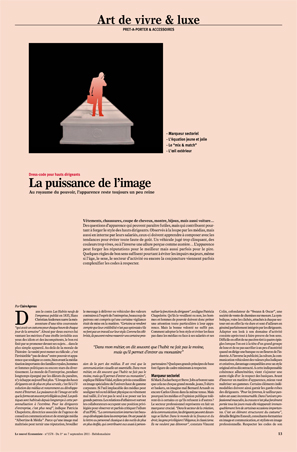Article - Le Nouvel Economiste
Image power
In his 1835 fairy tale, The Emperor’s New Clothes, Hans Christian Andersen tells the story of the unfortunate story of a crowned head of state who “had a coat for every hour of the day of the week.” Cheated by two crooks who proclaimed the merits of a material that was invisible to the eyes of anyone who was stupid or unfit for his office, the king ended up in a procession in front of his subjects… in his birthday suit. Over and above the moral of the story – that vanity can lead to ridicule – there is the inevitable “lockstep” between power and appearance that gives the tale its power, long before royal families, politicians or entertainment stars were so prominent in the media.

The world of business had long been spared from the dictatorial effects of the need to look right, but that time is now over. “The image of top managers is under ever increasing scrutiny, linked to the growth of the media and the development of the internet. The power of image is such that form often triumphs over substance. Politicians have long been used to this extreme focus on personality. For business leaders, it is a more recent phenomenon,” explains Patricia Chapelotte, associate director of “Albertine & Media,” a communications and media strategy consultancy. Because a poorly maintained image can tarnish a reputation, blur the message to be delivered or convey values that run contrary to the company’s mission, many leaders have reached the conclusion that a more thoughtful approach is merited. “Some leaders realise that they can’t optimise their credibility if they don’t work on their style. Like celebrities, they may feel a certain pressure from the media. It is true that visual communication is essential. In my field, we often say that you can’t judge a book by its cover, but it your appearance can mean you’re left on the shelf,” explains Hélène Vidal, a private stylist who acts as an image consultant for high-end, corporate clients. While the watchful eye of the media can emphasise certain physical defects or poorly fitting clothes, it’s not alone in focusing on senior business leaders. Business partners and employees, in particular, are in a privileged position to observe a CEO’s appearance – and sometime to criticise it as well. “Internal communication has grown and developed substantially in companies, and we’ve moved on from the traditional round robin letter to all staff, towards more and more powerful tools that also play their role in making the leader’s role a much more personal one,” emphasises Patricia Chapelotte. Whether or not they want to, men and women in positions of power must therefore pay particular attention to their appearance – but goodwill is not enough.
How can they adopt the right style and avoid stumbling in front of the media or their employees and business partners? Some basic principles seem to create a basic framework to adhere to Industry matters - While Mark Zuckerberg and Steve Jobs can show up in jeans, T-shirts and trainers without shocking anyone, it’s hard to imagine LVMH’s Bernard Arnault or even Renault’s Carlos Ghosn in the same outfit. But why do media and public opinion allow tolerance for some people that they refuse to others. In fact, the industry sector can represent a clear, crucial dividing line. “In the creative sector and marketing and communications, leaders can afford to appear a bit more relaxed. In the worlds of finance and law, people favour elegance and tradition. They don’t want to draw the wrong kind of attention to themselves,” affirms Vincent Colin, co-founder of “Swann”, a company that sells made-to-measure shirts. The symbols and even clichés that apply to each sector die hard and in general are fully absorbed by the sector’s senior managers. Adapting your style to your line of business is seen as a demonstration of common sense and shared values. It’s tough, therefore, to avoid being dressed to the nines as the head of a large group in the luxury sector, and tough to do without a little austerity as a captain of industry or the head of a bank. On the other hand, advertising, marketing, and the cultural sector convey more playful and creative values that are more compatible with a more original or relaxed look.
Added to this essential consistency between appearance and industry, there is another golden rule: to respect the basics. Before innovating in terms of appearance, you have to be adept at dealing with simple stylistic challenges, and managers should therefore make space in their wardrobe for some timeless classics. “For women, a trouser suit is an essential. In the business world, men don’t necessarily wear ties every day but they inevitably reappear for big events. Ties add structure to a suit,” explains Brigitte Esnoult, who provides training and consultancy around image and communications, as well as a stylist who specialises in creating a professional image.
Read the PDF article
 Back
Back